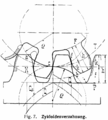Rack
The rack was originally a vertically mounted technical device with teeth, mostly made of metal , in order to be able to hang objects at different heights. So was z. B. in the kitchen, the temperature in pots over an open fire is regulated by changing the height of the rack ( kettle hook ).
In the course of advancing industrialization , racks were also used as machine elements. They are usually used to convert a rotary movement into a linear movement or vice versa.
Applications:
- Mountain railway technology ( rack railway )
- Moving machine parts with the help of an electric motor
- Steering gear
- Weirs
Geometry of the rack

- Geometries of racks
The geometry of the rack corresponds to the unwound geometry of a pinion with involute -, cycloidal - or Konchoidenverzahnung . The distance from one tooth to the next is the pitch of a rack. The division divided by gives the module of the rack.
The rack to a gear with involute flanks has straight flanks.
Applications
Rack and pinion drive
- How the rack and pinion drive works
Conversion from rotation to translation
In rack and pinion drives, the rack is a straight machine element with a series of elevations, the teeth, into which a gear wheel engages. The hub (or travel) of a rack drive is calculated according to the "middle circumference of the toothed rim of the driving gear, the so-called" pitch diameter and the number of revolutions to
- .
Analogously, resulting speed (or feed rate ) of the rack by using the rotational speed to
- .
Alternatively, the angular speed of the gear can be used to calculate:
- .
With the rack and pinion drive, the axis of rotation of the gear is orthogonal to the direction of displacement of the rack.
Examples of motion conversions:
- Generating a rotary movement by moving the rack with a hydraulic cylinder. So z. B. tilting a Bessemer pear with the help of a rack and pinion drive.
- Generating a straight line movement by an electric motor
Dental splint
The best-known application of this system, however, is found in rack railways , where the rack is designed as a rack rail in the rail bed between or next to the leading and supporting rails. In rack railways, a distinction is made between various technical rail drive wheel systems such as B .:
- Rack systems of rack railways
Rack on railway sleepers
Drawer drive
Less known, but probably much more widespread, is the use of the rack and pinion drive as a drawer drive for CD players , DVD players , CD and DVD drives and other technical and electronic devices. In some CD and DVD drives, the laser unit is also moved by means of a reduction gear and a rack.
Rack and pinion steering
Another large field of application is use as a steering gear . The rack and pinion steering is used in particular in cars. A distinction is made between racks with constant and variable transmission. The variable translation is achieved by changing the tooth geometry via the rack stroke.
The Australian Arthur E. Bishop († 2005) invented the principle of variable toothing. In the 1940s, Bishop developed a steering system for the front wheel of an aircraft (US Patent 2,508,057), before a steering gear with variable teeth for use in a passenger car followed in the 1950s. The first patent was granted in 1958, with regard to variable toothing and its principle of changing the gear ratio, in the form of the wave type rack with eccentric pinion (US Patent 2,865,339). This represents the first patent of variable toothing for the automotive industry. In 1973 the use of variable toothing using a helical pinion was patented by Bishop (US Patent 3,753,378). In this form, the principle of variable toothing is still used today. In 1978, Bishop patented the Y-cross-sectional shape of a rack (US Patent 4,116,085).
In 1981 the Isuzu Piazza used a steering gear with variable toothing according to Bishop in connection with a helix pinion for the first time. The mass production took place at the company JKC from Japan, which used a hot forging process with subsequent cold stamping. In 1982 Bishop's variable toothing followed in a steering gear in the Holden JB. In the years that followed, Bishop developed process technologies for the mass production of variable racks with higher levels of accuracy than hot forging with cold stamping. In 1986, Bishop patented an apparatus for warm forging Y-shape racks with variable toothing (US Patent 4,571,982). In 2001, Bishop received the Australian Engineering Innovation Excellence Award for Bishop's forging technology for precision warm forging. In 2002, racks with variable teeth were used for the first time in Formula 1 . In 2003 Bishop received the PACE Award for the equipment for automatic precision warm forging of variable rack teeth. Bishop Steering Technology Ltd. still owns many patents. In 2010 the companies of the Bishop Steering Technology group were bought by the Georgsmarienhütte group (GMH group). The warm forging technology developed by Bishop for Y- and D-shape racks is still regarded today as the leading technology for the mass production of car racks with variable teeth.
Rack and pinion winch
Another application of the rack is the rack winch .
Web links
- Calculation tables for racks http://www.holtech-antriebstechnik.de/berechnung-stirnraeder-zahnstangen-modul-1


























